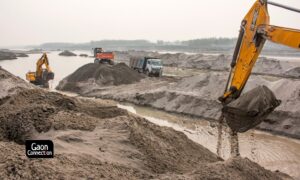Constantly migrating population due to lack of development and employment opportunities have been found to be the biggest factor behind the low voter turnout in the state of Uttarakhand in the assembly elections that were conducted in 2017.
The finding, which is based on an analysis by a Dehradun-based non-profit organisation Social Development for Communities (SDC) Foundation, mentioned that the COVID19 pandemic has further worsened the crisis of migration in the hill state.
SDC Foundation’s analysis stated that 82 per cent of the hill constituencies (28 out of 34) in the nine hill districts had a vote share that was lower than that of the state average of 65.60 per cent.
Also Read: When COVID-19 reached remote, mule-track villages in the upper reaches of Uttarakhand
The non-profit’s analysis underlined that migration, which is especially prevalent in the hill districts, reflects in the seat distribution in the Himalayan state.
“Lack of employment, inadequate education and limited health-care facilities have exacerbated the prolonged exodus. One of the many consequences of this phenomenon is the low voter turnout in 34 of the total 70 constituencies in the nine hill districts; viz. Pauri, Tehri, Chamoli, Uttarkashi, Rudraprayag, Almora, Pithoragarh, Champawat and Bageshwar in Uttarakhand,” the non-profit organisation stated in its report.
‘Voter turnout in upcoming elections expected to be even lower’
Citing reasons behind the migration of the citizens to other states, SDC Foundation stated that lack of employment, inadequate education facilities and limited healthcare access have exacerbated the prolonged crisis of migration.
“The main thing that needs to be emphasised here is that migration is the key likely reason behind such a low voter turnout. There can be other reasons too such as weather conditions on the voting day, access to polling booths which also need to be considered,” Anoop Nautiyal, the founder of SDC Foundation told Gaon Connection.
Nautiyal also stated that the voter turnout for the upcoming assembly polls in the state which will witness voting on February 14 is expected to be even lesser.
Also Read: Death toll due to heavy rainfall, flash floods and landslides in Uttarakhand rises to 52; 5 missing
“My guess is that in 2022, voter turnout might be even lower than 2017 and there are numerous reasons behind it. In addition to migration, even the COVID19 situation will play a key role in it. The restrictions due to COVID19 may limit travel for people so the Election Commission needs to make special arrangements keeping this in mind,” he added.
Hill districts register lower voter turnout than plains
The SDC foundation analysis found that the highest polling percentage was in the districts of Udham Singh Nagar (76.01 per cent), Haridwar (75.68 per cent) and Uttarkashi (69.38 per cent) whereas the lowest polling percentage was in the hill districts of Almora (53.07 per cent), Pauri (54.86 per cent) and Tehri (55.68 per cent).
Laksar (81.95 per cent), Haridwar Rural (81.76 per cent) and Piran Kaliyar (81.6 per cent) in the plain district of Haridwar were the three constituencies with the highest voting turnout in Uttarakhand. Thus, voter turnout was in the 81-82 per cent range in the three constituencies.
On the contrary, Salt (46.01 per cent) in Almora district and Chaubatakhal (46.91 per cent) and Lansdowne (47.87 per cent) in Pauri district had the lowest voter turnout. Thus, voter turnout was in the 46-48 per cent range in the three constituencies. Similarly, with 49.19 per cent voting turnout, Ghansali in Tehri district also had a voting percentage below 50 per cent. Thus, there were four hill constituencies in the state with voter turnout below 50 per cent.
Also Read: Dehradun’s smart water ATMs provide clean drinking water at an affordable price
All five constituencies in the city of Dehradun, Raipur (59.77 per cent), Mussoorie (58.06 per cent), Rajpur Road (58.01 per cent), Dharampur (57.56 per cent) and Dehradun Cantt (57.14 per cent) had voting below 60 per cent.
On the basis of this data, it deduced that in most hill constituencies, the total average number of voters was in the range of 45,000-60,000. While the total electors were quite low in these constituencies, even the vote share was also very low.
Talking about how economic hit might also have an impact on voter turnout this election, Nautiyal added, “Many people have been economically hit due to the different covid waves and they might not have enough money to return to their hometowns to vote and that will also impact the voter turnout.”














